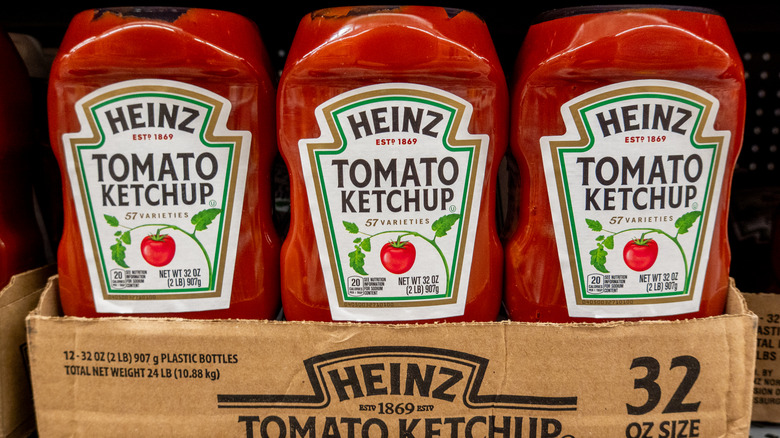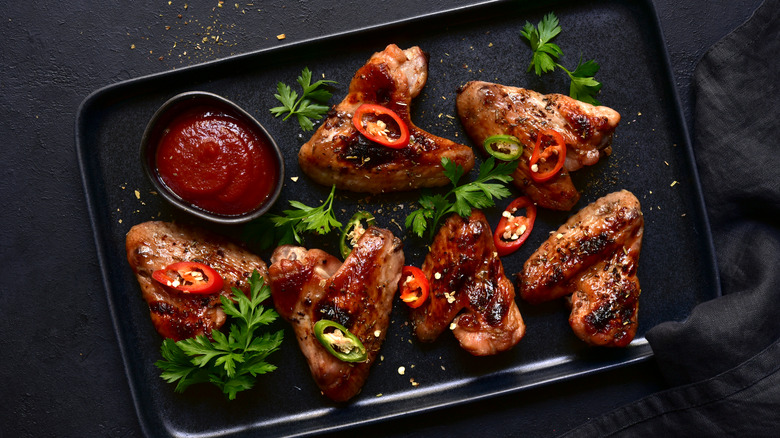The Controversial Condiment Jacques Pépin's Uses Often
Jacques Pépin is the kind of seasoned chef worth turning to for any and all cooking advice. The legendary French cook has extolled plenty of culinary wisdom during his long career, from tips on how to execute the perfect soufflé to selecting the right eggs for your endeavors. Even as a trusted source, Pépin has his fair share of controversial food opinions. In fact, he's known to rely on a decidedly humble condiment: ketchup.
Yes, the ingredient you'd more readily associate with fast-food French fries than gourmet cooking is a staple in many of Pépin's recipes. He'll add the bright-red sauce to dishes that feature both fish and fowl, not to mention recipes that highlight pork. As for why Pépin chooses to use this tomato-packed mix in particular, he told the Pocono Record, "Ketchup or a thick tomato sauce has been used in French cooking for many years. It gives just the right amount of sweet and savory flavor and texture." There's plenty of science to back this claim up. Ketchup contains both sugar and vinegar, a sweet and tangy blend, as well as a boost of umami-rich glutamates from the tomato purée.
How Pépin uses ketchup
So how does Pépin use this ingredient in his own cooking? More often than not, the celebrity chef puts the tomato-rich condiment in the glazes and sauces he makes to accompany protein. From pork tenderloin to chicken livers, Pépin uses a little bit of ketchup-based glaze to balance out the savory protein in question. Take his recipe for spicy maple-glazed ham. The rich, salty ham is topped with a ketchup glaze that perfectly complements the meat's flavor. As for his baked salmon with sauteed endive, Pépin will coat a slab of salmon with a ketchup sauce before roasting it to tender perfection in the oven. He's also blended ketchup with mayonnaise and a few other creamy ingredients to create a remoulade-like red sauce to serve alongside a fat stack of crab cakes (per My Kentucky Home).
In other cases, Pépin uses ketchup as a flavorful thickener. For his classic Lyon-style chicken thighs, three tablespoons of ketchup help bulk up the texture of a vinegar glaze. Like tomato paste, the concentrated nature of ketchup will help bring both a luxuriant mouthfeel and taste to a sauce.
Making the most of the umami-rich condiment
When pairing other ingredients with ketchup, Pépin chooses either additions that work to enhance the natural sweetness of the ketchup or cuts through it with a bit of heat. For complementary sweet flavors, balsamic vinegar and maple syrup are two ingredients reliable ingredients — while Tabasco, wasabi, and sriracha are a good choice for a spicy touch. Pépin has also blended the ketchup with nutty toasted sesame oil and acidic lime juice (per PBS). Interestingly enough, Pépin often uses a very sparing amount of ketchup per recipe, about one to two tablespoons.
Applying Pépin's love of ketchup to your own cooking endeavors, think about making your own ketchup-powered glaze for your next pan-seared pork chop or roasted chicken thighs. If you'd like to thicken and enrich a sauce that you plan to pair with your hamburger steaks or salmon filets, consider adding a squeeze of ketchup. Plus, imagine how delicious this could be if you choose to make your own homemade ketchup. Take it from Pépin — a little bit of ketchup goes a long way to enhancing the flavor of your cooking.



